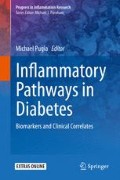Abstract
The impact of the peptides such as 32 amino acid peptide AdipoR1 C -terminal fragment (CTF) (AdipoR CTF344-374) can be studied in cell and animal models provided the conditions are defined for the biological system tested. In this work, calcium depleted cardiomyocytes (C2C12) were found useful as cell model for study of Ig-CTF formation and release. This cell model could be a useful tool for screening of compouns to block formation of CTF. A breast cancer cell model (SKBR-3) with labeled insulin was found useful for measurement of cellular loading and inhibition of insulin degradation. This cell model could be a useful tool for screening of compounds to block CTF inhibition of IDE. Leptin resistant rat models were shown to become hyper-insulinemic when treated with CTF allowing a model for inducing insulin resistance. The progression of leptin resistant rats to diabetes was measure-able by their oral glucose tolerance and plasma CTF levels. This animal model supported that AdipoR CTF raises intracellular plasma insulin but not glucose and is an important factor in diabetic progression. Together these models allow exploring formation and signaling of new inhibitory plasma peptides and demonstrate how to explore bioactivity of proteomic discoveries with cell and animal models.
Access this chapter
Tax calculation will be finalised at checkout
Purchases are for personal use only
References
An D, Rodrigues B (2006) Role of changes in cardiac metabolism in development of diabetic cardiomyopathy. Am J Physiol Heart Circ Physiol 291(4):H1489–H1506
Bråkenhielm E et al (2004) Adiponectin-induced antiangiogenesis and antitumor activity involve caspase-mediated endothelial cell apoptosis. Proc Natl Acad Sci U S A 101(8):2476–2481
Cable JC et al (2014) The effects of obesity, diabetes and metabolic syndrome on the hydrolytic enzymes of the endocannabinoid system in animal and human adipocytes. Lipids Health Dis 13:43
Carling D (2005) AMP-activated protein kinase: balancing the scales. Biochimie 95:87–91
Chang L, Chiang SH, Saltiel AR (2004) Insulin signaling and the regulation of glucose transport. Mol Med 10:65–71
Clark J, Palmer CJ, Shaw WN (1983) The diabetic Zucker fatty rat. Proc Soc Exp Biol Med 173:68–75
Copps KD, White MF (2012) Regulation of insulin sensitivity by serine/threonine phosphorylation of insulin receptor substrate proteins IRS1 and IRS2. Diabetologia 55(10):2565–2582
de Artiñano A, Miguel Castro M (2009) Experimental rat models to study the metabolic syndrome. Br J Nutr 102(9):1246–1253
Doyle ME, Egan JM (2007) Mechanisms of action of glucagon-like peptide 1 in the pancreas. Pharmacol Ther 113:546–593
Dugani CB, Klip A (2006) Glucose transporter 4: cycling, compartments and controversies. EMBO Rep 6(12):1137–1142
Gorden P, Gavrilovay O (2003) The clinical uses of leptin. Curr Opin Pharmacol 3:655–659
Hardie DG (2004) The AMP-activated protein kinase pathway – new players upstream and downstream. J Cell Sci 117:5479–5487
Hayashi T et al (2000) metabolic stress and altered glucose transport activation of AMP-activated protein kinase as a unifying coupling mechanism. Diabetes 49:1–5
Jessen N, Goodyear LJ (2005) Contraction signaling to glucose transport in skeletal muscle. J Appl Physiol 99:330–337
Kava R, Greenwood MRC, Johnson PR (1990) Zucker (fa/fa) rat. ILAR News 32(3):4–8
Ojuka EO (2004) Role of calcium and AMP kinase in the regulation of mitochondrial biogenesis and GLUT4 levels in muscle. Proc Nutr Soc 63:275–278
Pavón FJ, Serrano A, Pérez-Valero V, Jagerovic N, Hernández-Folgado L, Bermúdez-Silva FJ, Macías M, Goya P, de Fonseca FR (2008) Central versus peripheral antagonism of cannabinoid CB1 receptor in obesity: effects of LH-21, a peripherally acting neutral cannabinoid receptor antagonist, in Zucker rats. J Neuroendocrinol 20 Suppl 1:116–123
Schmidt RE (2003) Analysis of the zucker diabetic fatty (ZDF) type 2 diabetic rat model suggests a neurotrophic role for insulin/IGF-1 in diabetic autonomic neuropathy. Am J Pathol 163:21–28
Shibata R et al (2004) Adiponectin-mediated modulation of hypertrophic signals in the heart. Nat Med 10(12):1384–1389
Shimizu H, Oh-I S, Okada S, Mori M (2009) Nesfatin-1: an overview and future clinical application. Endocr J 56(4):537–543
Shin JA et al (2013) Metabolic syndrome as a predictor of type 2 diabetes, and its clinical interpretations and usefulness. J Diabetes Investig 4(4):334–343
Siddle K (2011) Signaling by insulin and IGF receptors: supporting acts and new players. J Mole Endocrinol 47:R1–R10
Tirabassi RS et al (2004) The BBZDR/Wor rat model for investigating the complications of type 2 diabetes mellitus. ILAR J 45(3):292–302
Wang Y et al (2005) Adiponectin Inhibits cell proliferation by interacting with several growth factors in an oligomerization-dependent manner. J Biol Chem 280(18):18341–18347
Yamauchi T et al (2002) Adiponectin stimulates glucose utilization and fatty-acid oxidation by activating AMP-activated protein kinase. Nat Med 8(11):1288–1295
Zhou L et al (2009) Adiponectin activates AMP-activated protein kinase in muscle cells via APPL1/LKB1-dependent and phospholipase C/Ca2+/Ca2+/calmodulin-dependent protein kinase kinase-dependent pathways. J Biol Chem 284(33):22426–22435
Acknowledgements
We would like to acknowledge the animal work done by PreClinOmics Inc (Indianapolis, IN) including Dr. Richard Peterson, Dr. WK Yeh, Troy Gobbett and others who conducted animals trials, samples and performed on-site testing. We would like to acknowledge the work done inside Bayer Healthcare Diagnostic on cell models by Dr. Manju Basu, Karen Marfurt and Ronald Sommer.
Author information
Authors and Affiliations
Corresponding author
Editor information
Editors and Affiliations
Supplements
Supplements
-
IHC and ICC Cell Staining Methods
-
Western Blot Methods
Rights and permissions
Copyright information
© 2015 Springer International Publishing Switzerland
About this chapter
Cite this chapter
Pugia, M., Ma, R. (2015). Cell and Biological Models for the C Terminal Fragment of Adiponectin Receptor. In: Pugia, M. (eds) Inflammatory Pathways in Diabetes. Progress in Inflammation Research. Springer, Cham. https://doi.org/10.1007/978-3-319-21927-1_5
Download citation
DOI: https://doi.org/10.1007/978-3-319-21927-1_5
Publisher Name: Springer, Cham
Print ISBN: 978-3-319-21926-4
Online ISBN: 978-3-319-21927-1
eBook Packages: Biomedical and Life SciencesBiomedical and Life Sciences (R0)

